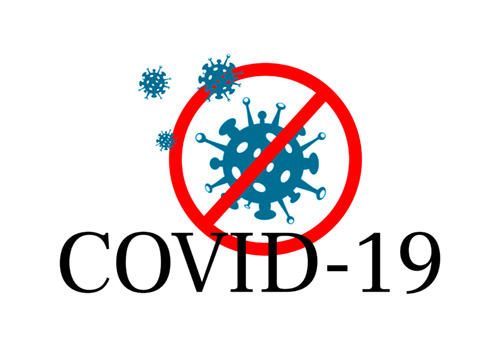NAAD – COVID-19 Guidance for Ventilation Hygiene
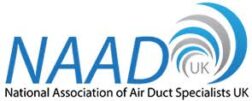
This is a transcription of a recent document produced by the NAAD UK offering Covid-19 guidance on ventilation systems. Used with permission
For the benefit of our members and all building managers, we are issuing this guidance to provide a better understanding of the role of ventilation systems in the current Covid-19 pandemic. The guidance concentrates on the airborne transmission route only as it relates heavily to ventilation systems.
This guidance is supplementary to all government guidelines in relation to social distancing, hand washing, essential travel and staying at home, etc.
The scope is limited to commercial and public buildings such as offices, factories, schools and hotels where normal social transmission is possible. Hospitals and healthcare facilities are excluded due to the higher risk of contact with Covid-19 and the specialised work procedures required
Disclaimer:
This NAADUK document is based on best available information on Covid-19, which is limited or non-existing. SARS-CoV-1 information has been used for best practice recommendations. NAADUK will not accept liability for any direct, indirect, incidental damages or any other damages that may relate to the use of the information presented in this document. The document is for guidance only and all buildings and ventilation systems operate in a bespoke manner specific to the building. Building owners must ensure they complete their own in-house risk assessment before implementing any Covid-19 control procedures, including a technical and microbiological risk assessment on the HVAC Systems.
1.0 Background
1.1 We have reviewed two reports, one from RHEVA 3rd April 2020 and one from Refcom in March 2020. Both made valuable points, some we agree with and some we don’t.
1.2 In the interest in providing best practice guidance, we have reviewed and discussed the technical content of the publications and supplemented appropriate content with additional information to illustrate the effects of mechanical ventilation on Indoor Air Quality and the risk of exposure to Covid-19 and other airborne organisms.
2.0 Covid-19
2.1 Because Covid-19 or Cov2 information is so limited, information from Sars1 is used for guidance. This assumes the virus can stay active for up to 3 hours in indoor air and can stay active for 2-3 days on room surfaces at common room temperatures. Airborne viruses have caused infection in the past and Sars1 and is likely to be similar to Covid-19, but as of yet, not documented.
2.2 The recent report of swabs taken by exhaust vents in a room occupied by infected patients, implies that a 1-2 metre distance might not be enough to prevent the transmission of the virus. Toilet extract grilles have tested positive for Covid-19.
2.3 Increasing ventilation (fresh air) is proven to be beneficial in the removal of infectious virus and particles and reducing the risk of transmission.
2.4 To minimise the risk of airborne transmission, use the ALARA principle (as low as reasonably achievable). We will advise on recommended practice further on.
3.0 Ventilation Systems
3.1 Ventilation systems are installed to provide clean, conditioned air to the building occupants.
3.2 A clean ventilation system is an essential part of a healthy building.
3.3 Airborne containments can be minimised and removed from the building by effective filtration and regular cleaning and maintenance of the ventilation systems. There is detailed guidance on this throughout the document.
4.0 General guidance on building services operations to improve ventilation hygiene.
4.1 Ventilate space with outdoor air if possible.
4.2 Switch ventilation to operational speed at least 2 hours before the building usage time and switch to lower speed 2 hours after the building usage time. This will clean the air before use and after use by utilizing higher air change rates.
4.3 At nights and weekends, do not switch ventilation off, but run systems at lower speed.
4.4 Open windows for regular airing (even mechanically ventilated buildings).
4.5 Keep toilet ventilation 24/7 in operation.
4.6 Avoid open windows in mechanically ventilated toilets to assure the right direction of ventilation. This must be reviewed by the user.
4.7 Instruct building occupants to flush toilets with the lid closed.
4.8 Switch all air handling units with recirculation to 100% outdoor air with the recirculation damper closed and ensure the fresh air and exhaust air dampers are open. See diagrams further on.
4.9 Inspect heat recovery equipment to be sure that leakages are under control.
4.10 Switch fan coils either off completely or operate so that fans are continuously on.
4.11 Do not change heating, cooling and humidification setpoints.
4.12 Visually inspect all ductwork systems at the grilles and diffusers. Blocked grilles and grille dampers reduce ventilation and increase risk of Covid-19 transmission. This is mainly applicable to extract and return air grilles, especially toilet extracts. See diagrams further on.
4.13 This is an ideal time to plan essential duct cleaning work as the building will not be occupied. The system should be cleaned if following an inspection:
4.13.1 The airflow is restricted due to soiling of grilles and grille dampers.
4.13.2 There is a risk of foreign matter falling from extract/return air grilles into room.
4.13.3 The system does not meet statutory hygiene requirements.
4.14 Replace Air Handling Unit, Fan Coil Unit and all other filters as usual in accordance with manufacturer’s recommendations.
4.15 Regular filter replacement and maintenance works shall be performed with common protective measures including respirator protection
5.0 HVAC System operation to improve ventilation hygiene.
By maximising the ventilation in the building, the risk of transmission of Covid-19 will be reduced significantly. Maximising ventilation and ventilation hygiene is achieved by:
5.1 Only using outdoor or fresh air to ventilate the building.
5.2 Operating HVAC plant to obtain maximum air change rates.
5.3 Ensure system is balanced to achieve uniform air distribution and reduce dead spots.
5.4 Ensure extract and return air grilles are clear of restrictions or blockages caused by foreign matter lodged on them. In the case of Covid-19, toilet extract grille cleaning is critical due to suspected faecal aerosol transmission routes.
5.5 Change filters as per manufacturers guidelines as soiled filters will reduce airflow.
5.6 Inspect AHU coils for foreign matter as they can considerably reduce airflow.
Did you know?
On a recirculating system with an average velocity of 5m/s, 50 metres of supply duct and 50 metres of return duct, it would take approximately 25-30 seconds to re-introduce virus back into the room.
6.0 Filtration and Covid-19
6.1 Most general ventilation systems contain panel and bag filters that will not remove micro-organisms and viruses including Covid-19.
6.2 Some viruses have been known to penetrate hepa filters.
6.3 However, filter maintenance should be carried out as part of the normal operation of the system as filters stop large particles, contaminants, pollen, insects, etc entering the building.
7.0 Fan Coil Unit operation to manage Covid-19 transmission.
7.1 Fan coil units represent a reasonable concern for the transmission of Covid-19 due to way they function within an occupied space.
7.2 Fan coil units are generally installed above the ceilings of an area and recirculate the air locally within the space. In large open plan offices, there may be large quantities of fan coil units installed. These units generally contain coarse filters which do not filter small particles and may load with particles containing micro-organisms.
7.3 Consideration should be given to the following operation procedures:
7.3.1 If there is no significant cooling load, turn off the fan coil units altogether to avoid re-introduction of virus particles into the area.
7.3.2 Kill any micro-organisms or virus lodged on the filter by heating up the fan coil unit to 60 0C for one hour or 40 0C throughout the day.
7.3.3 If the fan coil unit cannot be switched off, run the fan continuously. Virus can lodge on the filters and a resuspension boost can occur on start-up when the fan is started.
7.3.4 Maximise exhaust ventilation to remove virus particles.
8.0 Effect of soiled extract/return air grilles in ventilation systems.
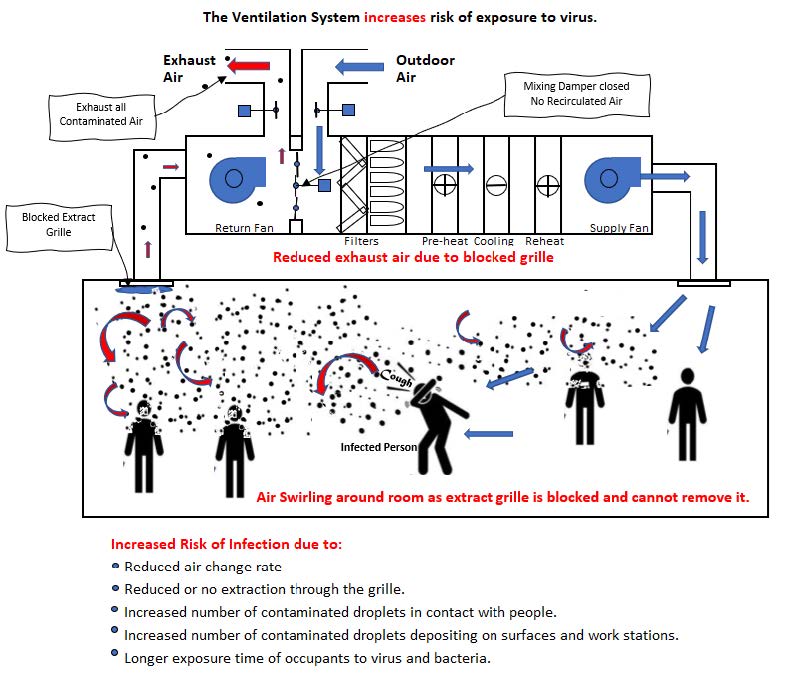
9.0 Effect of clean extract/return air grilles in ventilation systems.
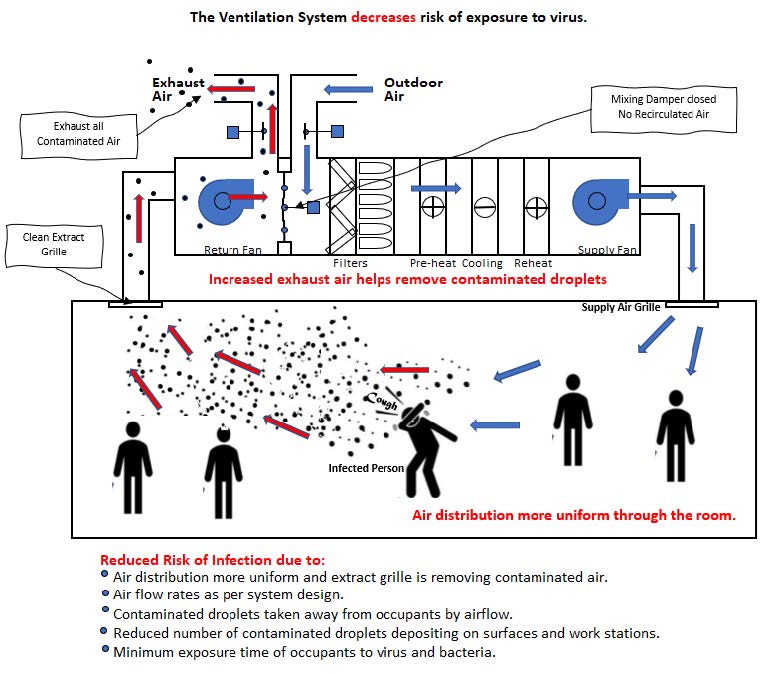
10.0 Effect of 100% Recirculation in a Building.
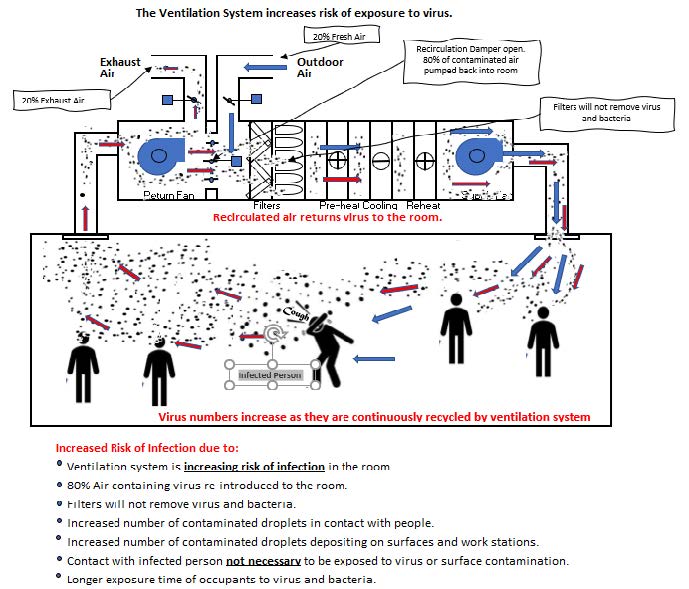
11.0 Effect of 100% Fresh Air in a Building.
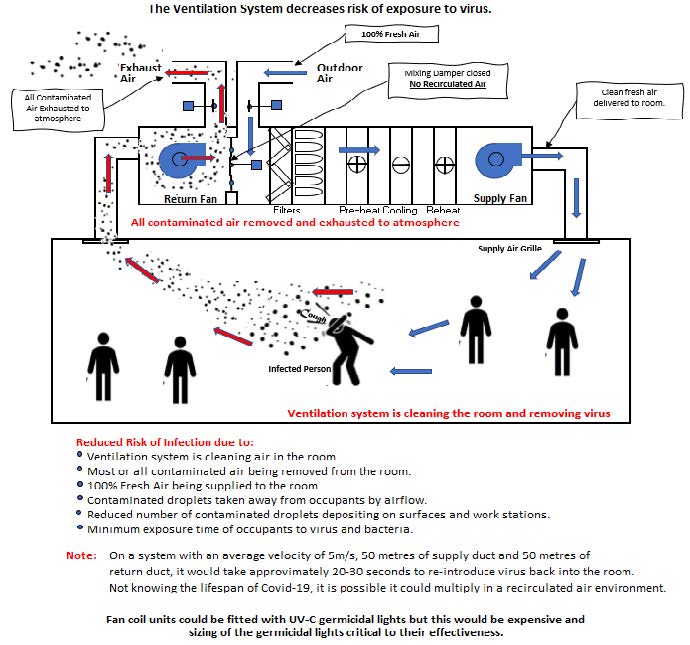
12.0 Effect of Air Change Rate on Contaminant Removal
12.1 The table below shows the effect of air change rate on contamination removal.
12.2 Ventilation and air change rates are critical to ventilation hygiene and to minimise the risk of Covid-19 transmission by aerosol.
12.3 In the test below, by increasing the air change rate from 2 ACH to 4 ACH, the contamination removal time is halved.
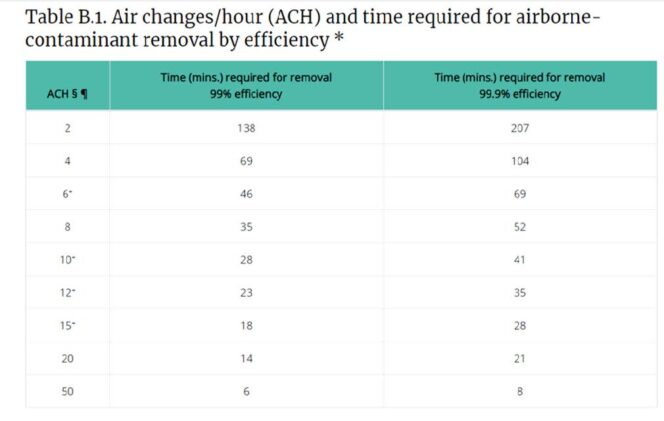
12.4 The photo of the extract grille below shows the part of the grille we don’t see from the
ground. The face of the grille might be cleaned by contract cleaners but the grille is fully
blocked. This is why professional ventilation system inspections are required.

12.5 A complete clean of extract (and supply) grilles requires that the grille face (or grille is removed and the diffuser, damper, grille box, flex and vertical duct are cleaned. A survey of the grilles is necessary before undertaking this work to establish the difficulty levels in cleaning various grilles installed to the stated level based on accessibility and grille type.
13.0 Recommendation to Members
Taking into account the above our recommendations for our members are as follows:-
13.1 Concentrate on the cleaning of extract air systems, particularly toilet extract systems and recirculating air systems in hospital, offices and factories.
13.2 Clean supply and extract systems in areas where Covid-19 infections occurred and decontaminate the buildings also if equipped to do so.
13.3 Advertise duct cleaning and damper testing whilst buildings are unoccupied so that when staff or guests return (offices, shops and hotels) the buildings are safe and ready for use. This is beneficial to the vent hygiene techs and the client while the buildings are unused.
13.4 Consider obtaining training on HVAC sanitizing and building sanitizing to supplement duct cleaning. There are various systems on the market such as electrostatic fogging, ozone fogging, etc. Proper training and certification is required to protect yourselves and the occupants of the buildings.
13.5 Safety:
13.5.1 Follow government guidelines in relation to social distancing, hand washing, essential travel and staying at home, etc.
13.5.2 Wear PPE & RPE at all times when working.
13.5.3 Decontaminate tools after use.
13.5.4 Always allocate where possible, same team same vehicles.
13.5.5 If using pool vehicles, decontaminate after use and also before using a different vehicle.
13.5.6 When not in vehicles always use face masks or improvised protection in general areas before switching to full PPE & RPE when working in possible contaminated areas.
13.5.7 Follow NHS guidelines for garbing and de-garbing PPE & RPE when working with Covid-19 review and sign off Method Statement and Risk Assessment with infection control manager before commencing any hospital work.
13.5.8 Stay Safe
Many of our member Companies operatives are working in the same infected areas as NHS and Care Home Staff during this outbreak. We are very proud of everyone’s efforts, so follow the guidance and safe working practices.
So please keep yourselves safe and thank you for all of your efforts.
Peter Reid – FIC – MPR
President of NAADUK
For a free quotation and survey please call 01 629 4122
© Copyright 2008 – 2020 Enviro Hygiene Specialists Ltd | Web design & development by WebBuddy
